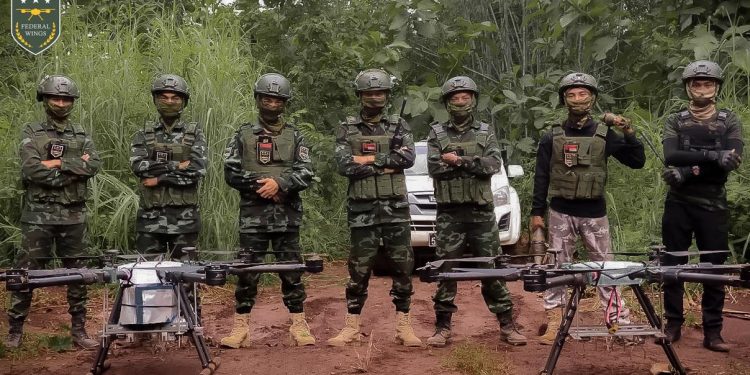The junta’s deputy home affairs minister is calling for regional and bilateral cooperation against the rising threat from drone attacks by terrorist groups worldwide while it is facing escalating drone attacks by resistance forces in Myanmar, saying they are the regime’s challenge of the future.
Lt-General Ni Lin Aung, who is also chief of the country’s police force, made the comments at the 2023 Conference of Global Public Security Forum, which was held last week in China’s Jiangsu province under the theme “One World, Common Security.”
Ni Lin Aung told the conference that “terrorist groups” are increasingly using drones worldwide, making their use a future challenge. He referenced a 2022 report—the “Global Terrorism Index”— by the Institute of Economics and Peace (IEP), but neglected to mention that “Myanmar was redacted from [the] report on May 10, 2022, in response to community feedback”, and that the
“IEP is assessing the situation in Myanmar for future publications.”
Myanmar’s top cop told the forum it is essential to enhance regional and bilateral cooperation to prevent weapons, including drones, from falling into the hands of criminals and malicious groups worldwide. Border controls should be strengthened to prevent so-called “terrorist groups” from receiving drones, he said.
Ni Lin Aung raised the issue of drones at the security forum as the regime’s forces, military bases and offices face increasingly effective drone strikes nationwide by resistance groups daily.

Regime military targets are being hit by drone strikes because resistance groups have learned how to bypass drone jammers.
On September 15, a video released by joint resistance groups showed their makeshift remote-controlled winged drone dropping two improvised bombs on aircraft hangars at Aye Lar military air base next to Naypyitaw International Airport, near the regime’s administrative capital.
Although no details of damage or casualties caused by the Naypyitaw drone strikes were released, Myanmar netizens praised the group’s ability to evade jamming equipment at the airbase to successfully conduct a drone strike.
In early September, resistance groups, including the Karen National Liberation Army, conducted successful drone strikes on the junta-run Myawaddy District Administration Department Office in Karen State’s Myawaddy Town, killing at least five regime officials, including a district administrator and a military battalion commander.
Another 11 police officers, including a police superintendent, suffered serious injuries and were treated at a hospital in the border town of Mae Sot in Thailand.
Many types of commercial drones have been used widely and effectively by resistance groups and allied ethnic armed organizations nationwide to bomb regime targets and surveillance operations.
Resistance groups are increasingly conducting aerial bombardments on regime targets by producing more improvised fixed-wing drones on their own.
The Defense Ministry of the civilian National Unity Government (NUG) recently said it had distributed over 400 drones to battalions of its armed wing, the People’s Defense Force, across the country for aerial attacks.
U Maung Swe, deputy secretary of NUG’s Defense Ministry, recently told RFA Burmese that their drones can be easily used despite the junta’s jammers, because they know the jammer frequency of anti-drone guns used by the regime.
Junta’s Home Affairs Minister Lt-General Yar Pyae last month agreed with his deputy, telling a meeting in Indonesia that drones have become the regime’s future challenge.
















